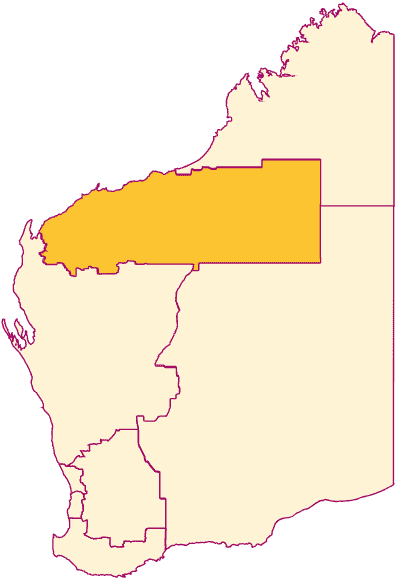Pilbara
Pilbara
Explore the Pilbara region, stretching from the picturesque Indian Ocean coastline to the rugged expanses of the Great Sandy Desert.

A scenic drive north from Perth transports you into the heart of ancient terrain amidst the world's oldest rocks and the enduring legacy of Aboriginal culture. Here, nature unfolds in all its splendour, revealing coastal archipelagos, majestic peaks, winding gorges, and the untamed beauty of the Australian outback.
Home to over 63,000 residents, the Pilbara has a vibrant population scattered across an area twice the size of the United Kingdom. While bustling coastal hubs like Karratha and Port Hedland teem with life, the region's diversity shines through with a melting pot of locals and individuals hailing from every corner of the globe, with a third of residents born beyond Australian shores.
Find out what it's like to live and work in the Pilbara.

Schools
Several primary and secondary schools in the larger mining towns of Karratha, Port Hedland, Newman and Tom Price provide academic and general courses, vocational certificates and engagement programs. Smaller towns and communities in the region have a primary or remote school, with some secondary education options available.
Students
With families drawn by mining opportunities, the Pilbara boasts multicultural classrooms. Aboriginal people represent almost 14% of the population in the Pilbara. Teachers navigate this dynamic environment with cultural sensitivity and innovative teaching strategies, fostering trust and connection within the community.
The region encompasses over 31 traditional Aboriginal language groups, so cultural awareness and an appreciation of the importance of family and relationships are essential in establishing trust and building good working relationships with students, their families and the wider community.
Teachers and staff
Teachers must have a broad understanding of how students learn and be confident in classroom management strategies to meet the needs of their students.
Pilbara schools are often a mix of experienced staff and those new to teaching or leadership positions. There is a strong focus on creating culturally responsive learning environments that build on the strength of students, providing high levels of passion and support within the school. Teachers need to be adaptable, resilient and able to work closely with their colleagues.
Staff work in corporate support roles at the Pilbara Education Regional Office in Karratha.
Weather and climate
The Pilbara has 2 definitive seasons, hot and dry, or hot and wet. The coastal towns experience mild winters but high humid temperatures over the summer.
Cyclone season extends from November to April and while you need to be aware and prepare, the housing and facilities are built to withstand cyclonic winds. Inland, the towns experience extremely high temperatures and extended dry periods.
Economy
The Pilbara is home to Australia’s resources industry which is integral to the local and state economy. This includes mining and supplying crude oil, salt, natural gas and iron ore to a world market. Most of Australia’s iron ore comes from the Pilbara and is exported through Port Hedland.
The Pilbara’s strong and expanding resources sector employs thousands of workers and continues to provide significant opportunities for employment and business development for residents and fly-in fly-out workers.
Housing options
Housing for teachers (and some other eligible staff) is provided through the Government Regional Officers Housing (GROH) program with generous allowances and additional benefits. The cyclone-proof houses are air-conditioned, and subsidies are offered to teachers in the region to help with the cost of living.
Things to do
If you have an adventurous spirit, and love four-wheel-driving, camping, diving, fishing, hiking and exploring, teaching in the Pilbara might be the right choice to suit your lifestyle.
Port Hedland and Karratha are less than a day’s drive from some of Western Australia’s most unique and beautiful landscapes including Karinjini and Millstream Chichester National Parks, Exmouth, Coral Bay and Broome.
There is remarkable history and Aboriginal culture to discover throughout the region including rock art and carvings, with some dating back at least 40,000 years - more than 10 times older than the pyramids of Egypt.
With so much to experience right on your doorstep, living and teaching in the Pilbara offers you a once-in-a-lifetime opportunity to truly immerse yourself in untamed beauty, culture and community.
The Pilbara offers unique ancient landscapes, rich with Aboriginal culture and endless adventures.
The Pilbara offers unique ancient landscapes, rich with Aboriginal culture and endless adventures.






Tourism WA image credit
Location images for Western Australian education regions are from Tourism Western Australia.






